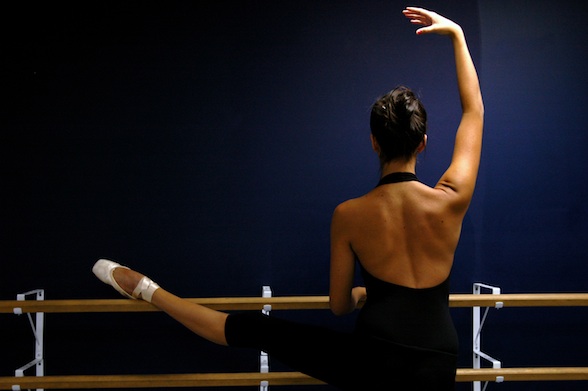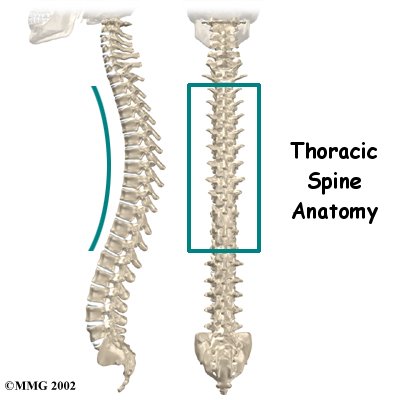Beneath the layers of all dance styles and aesthetic is a dancer’s technique and alignment. Without that base, dancers are at risk for injury. As dance teachers, you instruct and correct dancers on proper alignment to keep your dance students healthy.

If you need a refresher or would like to direct your dance students to a convenient, straightforward guide to alignment, come along on this trip around the torso:
Alignment of the Pelvis
When correcting torso alignment I begin with the hips. To assess proper positioning of the hips, have the dancer stand in first position and look at where the dancers hip bones (more specifically the anterior superior iliac spine) are in relationship to the pubic bone.
 Ideally, the hip bones and pubic bone are in the same frontal plane. This “neutral” position is the safest to work from. If the hip bones are forward of the pubic bone, the hips are in an anterior tilt. Usually, in this position, the dancers lower back is arched or swayed, affecting turnout and leg alignment. If the pubic bone is forward of the hip bones the hips are in a posterior tilt, or “tucked under.” Frequently, if the dancer has scoliosis, the hips are tilted laterally (from side to side).
Ideally, the hip bones and pubic bone are in the same frontal plane. This “neutral” position is the safest to work from. If the hip bones are forward of the pubic bone, the hips are in an anterior tilt. Usually, in this position, the dancers lower back is arched or swayed, affecting turnout and leg alignment. If the pubic bone is forward of the hip bones the hips are in a posterior tilt, or “tucked under.” Frequently, if the dancer has scoliosis, the hips are tilted laterally (from side to side).
Alignment of the Head and Spine
 The spine has several natural curves that help the body absorb shock and allow movement in a wide range of motion. Never strive for a completely flat back; instead, help your dancers find their individual best spinal position.
The spine has several natural curves that help the body absorb shock and allow movement in a wide range of motion. Never strive for a completely flat back; instead, help your dancers find their individual best spinal position.
When observing your students from the side, first check that their hips are in a neutral position. Then, adjust the position of the spine from the top down. Ears should be in line with the shoulders, and shoulders are over the greater trochanter of the femur (top of the thigh bone). The resulting spinal position may be slightly curved, but these are the natural curves your dancer needs to be safe.
Most students get into bad postural habits during their daily lives that carry over into dance classes. Spending several hours hunched over a computer will train a student’s body to rest in a hunchbacked position. Remind students to carry their dance posture into their daily lives so that they are practicing good habits all day long.
More on the spine and its alignment in The Stem of Aplomb series.
Supporting Alignment with the Abdominals
There are four layers to the abdominal wall. The most superficial is the rectus abdominus, or 6-pack. This is responsible for trunk flexion (bending the body forward). Next are the obliques, the muscles that twist the body at the waist. These also help with trunk flexion.
The deepest layer is the transverse abdominus. This is the muscle that “holds your lunch in” as I like to say. The transverse is also responsible for creating the intra-abdominal pressure that supports your spine.
Although each layer of the abdominal wall has it’s own specific task, it is most effective to use all of the layers together. For instance, during a circular port de bras, the abdominal muscles working to move the body are the obliques and rectus abdominis. However, if you neglect to use your transverse, then you will lose the desirable lifted look. You give the impression of flopping or rolling your torso around rather than gliding it effortlessly in a circular motion.
This is why it is so important that we remind our students to support with their core throughout class.
Alignment of the Rib Cage and Shoulders
It is important that we keep the front of the rib cage “knit together” so that it’s movements do not compromise the position of the spine. Allow adjustments for breath and the movement of the spine. However, the rib cage should follow the movement of the spine, not lead the movement of the spine.
Remind students to open their collarbones and glide their shoulders down. This places the shoulder joint in an open position that allows for movement of the arms in a wide range of motion without affecting the carriage of the shoulders, ribcage, or spine. This placement of the shoulders, and resulting dissociation of the arms from the body, is crucial to proper arm carriage and use.
Although the following guidelines apply to all dancers and all forms of dance, take into account that all bodies are different.
Individual flexibility, muscle imbalances, and physical habits contribute to how a dancer holds his/her body and applies corrections. Some dancers will be able to fix things right away and others may spend months stretching and conditioning in order to be able to make the smallest of adjustments.
Laurel Foley has been dancing for over 20 years, she earned her BA in Dance Pedagogy from Butler University. She currently teaches ballet and children’s dance at Style Dance Academy in Franklin, IN and is enrolled in the BASI Pilates teacher training program

Dance Advantage welcomes guest posts from other dance teachers, students, parents, professionals, or those knowledgeable in related fields. If you are interested in having your article published at Dance Advantage, please see the following info on submitting a guest post. Read posts from guest contributors.

